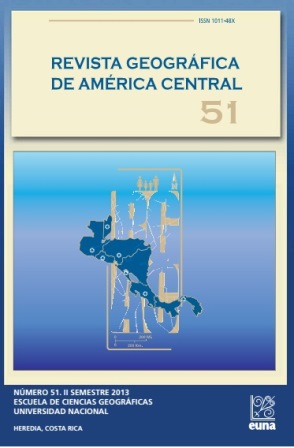POTENTIAL AQUIFER RECHARGE DETERMINATION FOR COSTA RICA’S COLD RIVER BASIN USING A GEOGRAPHIC INFORMATION SYSTEM
Keywords:
Río Frío Basin, Costa Rica, hydrogeological modeling, water balance, geographic information system, aquifer recharge zonesAbstract
In hydrogeology and water resources management, one of the priority areas of research involves studies of aquifer recharge from rainfall. These studies generally involve several methodologies, one being the implementation of water balance. In recent years, with the rise of geographic information systems in hydrogeological studies, ease of integration, management, consulting and modeling of geodata has allowed more accurate quantifying and modeling of groundwater. This article shows the potential aquifer recharge in the Río Frío (Cold River) Basin through the implementation of a soil-water balance from a series of geohydrological variables. Modeling of geodata in the geographic information system included spatial interpolation methods and map algebra. The information used for the construction modeled water balance to identify areas of potential aquifer recharge from rainfall.References
Arias, M. (2011). Estudio hidrogeológico regional de la cuenca del río Frío. Centro de Investigaciones en Ciencias Geológicas, Universidad de Costa Rica, San José, Costa Rica. [Informe interno]
Bear, J. & Cheng, A. (2010). Modeling Groundwater Flow and Contaminant Transport. New York: Springer.
Dingman, S. (2002). Physical Hydrology (2ª ed). Prentice Hall, New
Jersey.
Fetter, C. (2001). Applied Hydrogeology (4ª ed). Prentice Hall, New Jersey.
Hengl, T. & Evans, I. (2009). Mathematical and Digital Models of the Land Surface. En T., Hengl & H., Reuter (eds), Geomorphometry: Concepts, Software, Applications. 31-63. Amsterdam: Elsevier. INBIO (2010). Cartografía digital de la cuenca del río Frío, INBIO.
Kitanidis, P. K., (1997). Introduction to Geostatistics: Applications in Hydrogeology. Cambridge University Press, Cambridge.
Kresic, N. (2007). Hydrogeology and Groundwater Modeling (2ª ed.). CRC Press, Boca Raton. Marsily, G. (1986). Quantitative Hydrogeology. Academic Press, Orlando.
MINAET (2012). Metodologías Hidrogeológicas para la Evaluación del Recurso Hídrico. Alcance a la Gaceta, Diario Oficial La Gaceta, San José, Costa Rica, acuerdo 60-2012 del 31 de julio de 2012, resolución R-D-046-2012-MINAET del 01 de febrero del 2012, páginas 39-54.
Pinder, G. (2002). Groundwater Modeling using Geographical Information Systems. New York; Wiley.
Rubin, Y. (2003). Applied Stochastic Hydrogeology. Oxford University Press, Oxford.
Schosinsky, G. (2006). Cálculo de la recarga potencial de acuíferos mediante un balance hídrico de suelos. Revista Geológica de América Central, 34-35, 13-30.
Schosinsky, G. y Losilla, M. (2000). Modelo analítico para determinar la infiltración con base en la lluvia mensual. Revista Geológica de América Central 23, 43-55.
Ward, A. & Trimble, S. (2003). Environmental Hydrology (2ª ed). Lewis Publishers, Boca Raton.
Zaradny, H. (1993). Groundwater Flow in Saturated and Unsaturated Soils. Rotterdam: Balkema.
Downloads
How to Cite
Issue
Section
License
Proposed policy for journals offering Open Access
Authors publishing their works in the Journal acknowledge and agree to the following terms:
a) Authors retain the copyrights to their works and guarantee the Journal the right to be the first to publish their works, under the Creative Commons License Attribution-NonCommercial-ShareAlike 4.0 International, CC BY-NC-SA 4.0 International (https://creativecommons.org/licenses/by-nc-sa/4.0/deed.es), which allows others to share works upon complying with the acknowledgment of authorship and mention of the Journal as the original publisher of the work.
b) Authors are permitted to separately establish additional agreements for the non-exclusive distribution of the official edition of the work published in the Journal (for example, authors may desire to place the work in an institutional repository or incorporate it into a book that is to published elsewhere) so long they acknowledgment to recognize the Journal as the original publisher. The aforementioned additional agreements must respect the terms of the non-profit character and sharing philosophy of the original license (CC BY-NC-SA 4.0 International, https://creativecommons.org/licenses/by-nc-sa/4.0/deed.es).
c) Authors are encouraged to archive the post-print or editor/PDF version in Open Access repositories.






 REVGEO is licensed under https://creativecommons.org/licenses/by-nc-sa/4.0/deed.es
REVGEO is licensed under https://creativecommons.org/licenses/by-nc-sa/4.0/deed.es
.svg_4.png)

_(1).png)
_(1)_(1)_(1)_1.png)
(2)(1)(1)(1).png)
